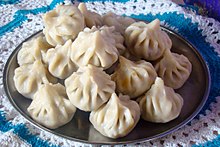 | |
| Alternative names | Koḻukattai Kangidan (歓喜団) Num kom (នំគម) Kanom nab (ເຂົ້າຫນົມແຫນບ) Bánh ít nhân dừa Kuih modak Kue modak |
|---|---|
| Course | Dessert |
| Place of origin | India |
| Region or state | India, Japan, Vietnam, Thailand, Laos, Cambodia, Myanmar, Malaysia, Indonesia, Brunei, Singapore |
| Main ingredients | Rice flour, or wheat, coconut, jaggery |
| Similar dishes | Cenil (Indonesia) Khanom tom/khanom kho (Thailand) Klepon (Indonesia) Mont lone yay baw (Myanmar) |
Modak (Marathi: मोदक) or Modakam (Sanskrit: मोदकम्), Modaka in Kannada, also referred to as Koḻukattai (கொழுக்கட்டை) in Tamil, and Kozhukkatta (കൊഴുക്കട്ട) in Malayalam[1] is an Indian sweet dish popular in many Indian states and cultures. According to Hindu and Buddhist beliefs, it is one of the favourite dishes of Ganesha and the Buddha and is therefore used in prayers.[2][3][4] The sweet filling inside a modak consists of freshly grated coconut and jaggery, while the outer soft shell is made from rice flour or wheat flour mixed with khowa or maida flour.[5]
There are two distinct varieties of Modakam, fried and steamed. The steamed version (called Ukadiche Modakam)[6] is often served hot with ghee.
- ^ S, Latha Maheswari (3 October 2015). So Tasty Healthy Low Calorie Vegetarian Cooking Book-2: Take care calorie by calorie DOSAS AND SOUTH INDIAN MOUTH WATERING VARIETIES. AB Publishing House. p. 130. ISBN 978-1-5176-3269-4.
- ^ Cite error: The named reference
favouritewas invoked but never defined (see the help page). - ^ "Indian classic: Modak". Traveldine. Archived from the original on 22 October 2022. Retrieved 1 September 2022.
- ^ "Culinary Capital: How Modaks, Ganesha's food, have broken barriers, travelled well through history". Indian Express. 4 September 2022.
- ^ "Modak Recipe".
- ^ "Jatra gets its flavour from Maharashtra for authentic taste". The Times of India. Indore. 7 October 2017. Retrieved 19 October 2017.